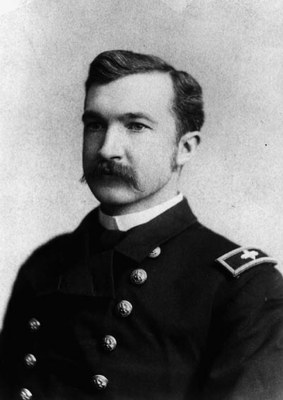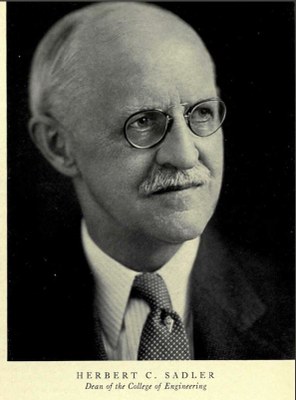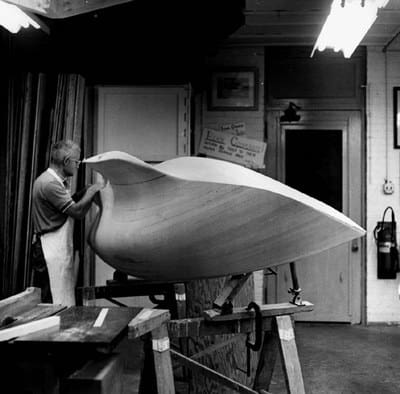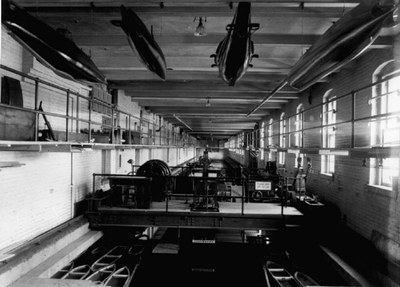History
1879-1920S
The University of Michigan’s educational program in naval architecture and marine engineering had its roots in an 1879 act of Congress, which authorized the U. S. Navy to assign a few officers to engineering colleges around the country.
THE “SCIENTIFIC BLACKSMITH”
Mortimer E. Cooley, an 1878 Naval Academy graduate, voiced an interest and was accordingly sent to the University of Michigan to teach “steam engineering and iron shipbuilding.” Upon his arrival he was one of but four professors of engineering at the University, at that time a department within the College of Literature, Science, and the Arts. Cooley always stressed the importance of balancing theory and practice in education, and often referred to himself as a “scientific blacksmith.” Despite his distinguished academic career, Cooley held no formal academic degree until after his retirement when the Naval Academy retroactively granted bachelor’s degrees to all its graduates.


Cooley’s energy and personal qualities soon placed him in a position of leadership on the campus, and in 1885 he resigned his commission to become a permanent member of the faculty. He envisioned a growing need for properly educated engineers in the marine field. This led him in 1898 to take his ideas to the University’s Regents, but he placed his plans on hold while serving shipboard during the Spanish-American War. Upon his return in 1899, the Regents appropriated $2000 to establish a curriculum in naval architecture and marine engineering, and Cooley was directed to identify and hire a professor of naval architecture while he was to continue teaching marine engineering. Cooley also developed a major new building to house engineering classrooms, offices, and laboratories, and integrated into its foundation a large model basin for scientific testing and development of ships’ hull forms; it was formerly known as West Engineering, but is known presently as West Hall.
Designing a Department

The search for U-M’s first professor of naval architecture was successfully concluded with the appointment of Prof. Herbert C. Sadler who had been teaching at the University of Glasgow. Sadler arrived on campus in 1900, ready to make UM’s educational program “second to none in the United States.” Soon thereafter he and Cooley established the Department of Naval Architecture and Marine Engineering (NA&ME), with Sadler as the department’s first Chair. Armed with findings from his newly commissioned model basin, Sadler soon became a world leader in scientific naval architecture. Both Cooley and Sadler would eventually serve as Deans of the UM College of Engineering, with Cooley being the founding dean in 1915. It was also during this time that the students of the department organized a student society that would become the Quarterdeck Society. An example of the pioneering teamwork provided by Cooley and Sadler came in 1914 with the offering of aeronautical engineering courses, following Sadler’s organization of the UM Aero Club in 1911. By 1916 a complete four-year aeronautical degree program was offered within the renamed Department of Naval Architecture, Marine Engineering, and Aeronautics. Aeronautics remained an option within the department until 1926.
1930s-world war II
Shipbuilding Legacy
The Great Depression was a period of little shipbuilding activity in the United States, and as a result, job opportunities in the marine field were almost non-existent. However, by the late 1930s, the unsettled world economic and political conditions resulted in the national decision to increase naval construction. As a result, shipbuilding experienced a resurgence, and employment opportunities for naval architects and marine engineers quickly improved.

During World War II NA&ME was heavily engaged in accelerated educational efforts and military research. The model basin was used to develop floating dry docks, amphibious vehicles, and other small military craft. All three regular members of the Department’s faculty (Profs Bragg, Baier, and Adams) helped push large classes of students through telescoped educational programs leading to bachelor’s degrees in three years instead of four. Prof. Baier served as a consultant to the War Department and to the Navy’s Bureau of Yards and Docks. In 1946 the Navy transferred the Reserve Officers Naval Architecture Group (RONAG) from Annapolis to Ann Arbor. In due time that activity trained 227 officers for Construction Corps duty.
After the war, many students in NA&ME were veterans receiving support under the “GI Bill.” NA&ME produced its first female graduate, Audrey Muller, who graduated in 1949 and went on to work for Bethlehem Steel Company’s Fore River shipyard in Massachusetts. In 1948 Harry Benford joined the department as assistant professor charged with teaching the initial course and assisting with the senior designs. He had graduated from Michigan in 1940 and then worked in various capacities at the Newport News shipyard. In trying to rationalize the ship design process, Benford discarded traditional approaches in favor of applied economic theory. He published his pioneering paper on this subject in 1956 and became best known for his efforts in that field.
1950S – 1970S
Industry and Alumni
The decade following the war was a period of rapid change in marine technology, principally in the design and construction of ships for the bulk trade of raw materials including oil. In 1957, a still-continuing tradition was started when Benford and two students, Judith Robinson and Paul Van Mater, initiated an alumni reunion coincident with the Annual Meeting of SNAME in New York City. Their New York contact was alumnus Klemme Jones (’49), who was then working at SNAME headquarters. Within two years another alumnus, Lester Rosenblatt (’42), voluntarily took responsibility for organizing the reunions and continued in that role until 1998, when his son, Bruce (’83), volunteered to shoulder the burden.
Program and Facilities Expand

In 1957, Richard B. Couch was induced to leave as Chief Naval Architect with the Navy Department’s Bureau of Ships to become Chair of NA&ME. He brought with him ambitious plans for improving the scope of the educational program and the capabilities of the model basin. His arrival coincided with the Soviet Union’s Sputnik I, and with the subsequent renewed national interest in science and engineering. As such, Couch put a strong emphasis on graduate education, and he persuaded the College to invest heavily in NA&ME’s laboratory facilities of the Ship Hydrodynamics Laboratory.
In 1960, the first NA&ME Ph.D. was awarded to Finn Michelsen, a student from Norway, who stayed on to manage the model basin and help develop several more Ph.D. graduates in the following years. In 1959 the U.S. Coast Guard asked the department to undertake a regular educational program for selected officers, leading generally to masters degrees.
A New Home
In 1967, Couch stepped aside to be replaced by Harry Benford as Chair of NA&ME. Enrollment in the department continued to grow, and Prof. Benford successfully recruited four new professors: T. Francis Ogilvie (theoretical hydrodynamics), Movses Kaldjian (structural analysis), Robert F. Beck (hydrodynamics and small craft design), and Michael Parsons (marine engineering). Ogilvie, who became Chair in 1974, was a vigorous innovator. His most visible act was physically moving the department from the West Engineering Building on the Central Campus to the North Campus, leaving behind only the model basin and associated facilities. With strong voluntary support from alumnus Hugh Downer (’39), Ogilvie led a capital campaign to double the size of the building on North Campus. Consequently, Ogilvie was able to provide more than just an enlarged and well-furnished building. He also had funds for new computers and research facilities, and seed money for new research initiatives. The department made the move to the North campus in 1977.
Historical footage from tank experiments and model construction is available during this period at Michigan Engineering’s YouTube page.
1980S ONWARD
Ever-Expanding Scope of NA&ME
In 1981 Prof. Ogilvie left Michigan to become Chair of Ocean Engineering at MIT and was succeeded by Prof. Parsons in October 1981, as NA&ME celebrated its centennial. During the 1980s, NA&ME faculty and students continued to employ experiments and analysis to solve problems in naval science and engineering, but research evolved to use newly developed computational methods for the analysis and design of ship and marine systems. This includes the work of Prof. Beck and Troesch in ship hydrodynamics and dynamics, Research Scientist Beier’s work in virtual reality, and Prof. Kaldjian’s work in Finite Element Methods (FEM).
Emerging Fields
Under the leadership of Chairs Beck, Bernitsas, and Troesch, the size and variety of the technical offerings of NA&ME continued to grow, with faculty working in both traditional and emerging areas of naval architecture and marine engineering. The latter includes research relevant to offshore and coastal science and engineering, robotic and autonomous underwater vehicles, numerical simulation of coupled flows and structures, and computer-aided design of marine systems. NA&ME researchers continue to work under the sponsorship of the US Navy, the shipbuilding and offshore industry, the recreational boat design and construction industry, and other commercial and private concerns.
125 YEARS AND GOING STRONG
In 2005–2006 the department celebrated its 125th Anniversary with dedication of the Rosenblatt Seminar Room and the Richard B. Couch Professorship of Naval Architecture and Marine Engineering (Advanced Marine Technology). In 2007, Prof. Robert F. Beck became the inaugural Richard B. Couch Professor of Naval Architecture and Marine Engineering, the first endowed professorship in the department’s history.
Still Setting the Standard
Professor Kevin Maki leads the Marine Hydrodynamics laboratory in West Hall. The model basin and ancillary labs remain a vital part of our educational and research mission. On the educational side, this includes the capstone laboratory course in the physical model basin, plus experimental components in other undergraduate classes. Ph.D. programs centered on fundamental research are plentiful, with commercial endeavors providing additional support for the overarching mission and enabling the acquisition of cutting-edge experimental instruments.
In 2018, the 112-year-old “tow tank” was given a makeover and a new name through a renovation project made possible by the family of 1943 NA&ME Alum Aaron Friedman. The renamed Aaron Friedman Marine Hydrodynamics Lab had renovations focused on making its workspaces more open, flexible, and collaborative, and on creating a space that’s more engaged with the campus around it. Improvements included a new interior vestibule, redesigned and updated; renovations to the corridor and offices to make them more open and versatile; an upgrade and relocated student computer lab; a gender-inclusive toilet room; and an LED light wall that tells the story of U-M’s unique naval architecture heritage and an exhibit wall that highlights the life of Aaron Friedman.

The carriage control system completed a comprehensive upgrade in 2024 thanks to an establishing gift by John Couch (NA&ME BSE MSE) in honor of his late father, Richard B. Couch. Couch spent a decade as Chair of UM’s Naval Architecture and Marine Engineering Department (1957-1967) and remained a close friend and supporter of NA&ME until his passing. The tow tank carriage has been named The Couch Carriage in his honor. The much-needed upgrades to the existing system were established when the prior control system began having operational outages due to failures in the control PC’s power supply and cabling.
An assessment of the existing system showed that the architecture of the control system was incompatible with a simple swapping of the control PC, as well as several areas for major improvement in maintainability and upgradability if the system were to be replaced wholesale. The implementation of the new control system also allows for an upgrade to the aging drive system. All four drive-shafts were rebalancing and refurbishing and the gearboxes and servomotors were all replaced. The downtime for these upgrades provided an opportunity also to install fully shielded stainless steel conduit runs for each of the four servomotors’ power and control cables, significantly reducing the electromagnetic interference the motors produced in the various instruments on the carriage during testing.

2020S EMBRACING THE BLUE ECONOMY
In 2021, ABS Professor of Marine and Offshore Design Performance David Dowling took over Chair duties and made hiring world-class faculty a major thrust of his leadership strategy.
The following year NA&ME added five new faculty to its ranks. The international search focused on candidates with research interests relevant to the blue economy such as ocean energy and marine-environmental engineering. Assistant Professor Anchal Sareen, a fluid dynamicist; Richard B. Couch Professor of Naval Architecture and Marine Engineering Krishnan Mahesh, whose research focuses on the simulation of complex, multi-physics turbulent flows; and Herbert C. Sadler Professor of Naval Architecture and Marine Engineering Lei Zuo who works on marine renewable energy. A subsequent faculty search added to the department Associate Professor Thomas McKenney, who is focused on maritime decarbonization and sustainability; and Professor of Practice Jonathan Page, who served in the United States Navy for 21 years including tours designing, acquiring, building, delivering, maintaining, and operating ships.
In 2024, the Board of Regents officially gave the green light to a $4.1M renovation project aimed at transforming approximately 8,400 gross square feet of the north campus NA&ME building classrooms, restrooms, the Undergraduate Marine Design Lab, and refreshing the two interior entries.